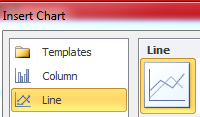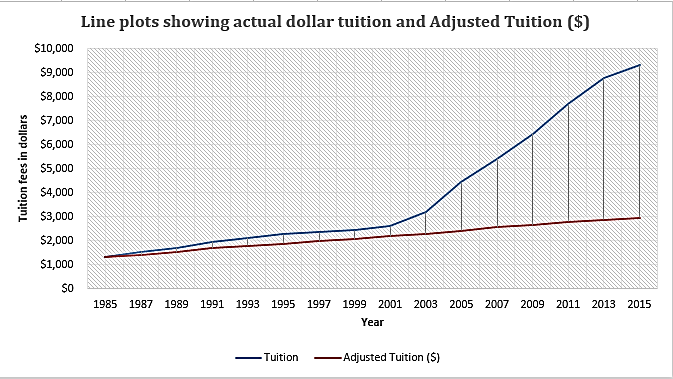
Concept explainers
To find: Each year’s tuition for Colorado residents at the University of Colorado in constant 1985 dollars by using annual average consumer price index (CPI).
Answer to Problem 25E
Solution: The required each year’s tuition in constant 1985 dollars is shown below:
| Year | Tuition | CPI | Adjusted Tuition ($) |
| 1985 | $1,332 | 107.6 | 1332 |
| 1987 | $1,548 | 113.6 | 1406 |
| 1989 | $1,714 | 124.0 | 1535 |
| 1991 | $1,972 | 136.2 | 1686 |
| 1993 | $2,122 | 144.5 | 1789 |
| 1995 | $2,270 | 152.4 | 1887 |
| 1997 | $2,356 | 160.5 | 1987 |
| 1999 | $2,444 | 166.6 | 2062 |
| 2001 | $2,614 | 177.1 | 2192 |
| 2003 | $3,192 | 184.0 | 2278 |
| 2005 | $4,446 | 195.3 | 2418 |
| 2007 | $5,418 | 207.3 | 2566 |
| 2009 | $6,446 | 214.5 | 2655 |
| 2011 | $7,672 | 224.9 | 2784 |
| 2013 | $8,760 | 233.0 | 2884 |
| 2015 | $9,312 | 238.7 | 2955 |
Explanation of Solution
Given: The tuition for Colorado residents at the University of Colorado is provided and the annual average consumer price index (CPI) is obtained from the table 16.1, for the respective years which are shown below:
| Year | Tuition ($) | CPI |
| 1985 | 1332 | 107.6 |
| 1987 | 1548 | 113.6 |
| 1989 | 1714 | 124.0 |
| 1991 | 1972 | 136.2 |
| 1993 | 2122 | 144.5 |
| 1995 | 2270 | 152.4 |
| 1997 | 2356 | 160.5 |
| 1999 | 2444 | 166.6 |
| 2001 | 2614 | 177.1 |
| 2003 | 3192 | 184.0 |
| 2005 | 4446 | 195.3 |
| 2007 | 5418 | 207.3 |
| 2009 | 6446 | 214.5 |
| 2011 | 7672 | 224.9 |
| 2013 | 8760 | 233.0 |
| 2015 | 9312 | 238.7 |
Calculation:
The formula to convert the amount from one period to another period is shown below:
Here, time B represents the present time and time A represents the base time.
Now, convert 1987 tuition in 1985 dollars as shown below:
Also, convert 1989 tuition in 1985 dollars as shown below:
Similarly, calculated each year’s tuition in constant 1985 dollars is shown below in the tabular manner:
| Year | Tuition | CPI | Adjusted Tuition ($) |
| 1985 | $1,332 | 107.6 | 1332 |
| 1987 | $1,548 | 113.6 | 1406 |
| 1989 | $1,714 | 124.0 | 1535 |
| 1991 | $1,972 | 136.2 | 1686 |
| 1993 | $2,122 | 144.5 | 1789 |
| 1995 | $2,270 | 152.4 | 1887 |
| 1997 | $2,356 | 160.5 | 1987 |
| 1999 | $2,444 | 166.6 | 2062 |
| 2001 | $2,614 | 177.1 | 2192 |
| 2003 | $3,192 | 184.0 | 2278 |
| 2005 | $4,446 | 195.3 | 2418 |
| 2007 | $5,418 | 207.3 | 2566 |
| 2009 | $6,446 | 214.5 | 2655 |
| 2011 | $7,672 | 224.9 | 2784 |
| 2013 | $8,760 | 233.0 | 2884 |
| 2015 | $9,312 | 238.7 | 2955 |
Interpretation: From the above table, it can be concluded that the adjusted tuition is increased as the CPI increased when the adjustment is done by taking the year 1985 as base.
To graph: The line plot of actual dollar tuition and constant dollars tuition on the same axes for the respective years.
Explanation:
Graph: The value of constant tuition dollar by taking 1985 dollars for the remaining years are obtained in the previous part. With the help of Excel, the two-line plots are obtained for the adjusted minimum wages and the minimum wages in constant dollars as shown below:
Step 1: Enter the data of actual tuition dollar and the constant dollar tuition during the respective years in the spreadsheet of Excel. The data is shown below:
| Year | Tuition | Adjusted Tuition ($) |
| 1985 | $1,332 | $1,332 |
| 1987 | $1,548 | $1,406 |
| 1989 | $1,714 | $1,535 |
| 1991 | $1,972 | $1,686 |
| 1993 | $2,122 | $1,789 |
| 1995 | $2,270 | $1,887 |
| 1997 | $2,356 | $1,987 |
| 1999 | $2,444 | $2,062 |
| 2001 | $2,614 | $2,192 |
| 2003 | $3,192 | $2,278 |
| 2005 | $4,446 | $2,418 |
| 2007 | $5,418 | $2,566 |
| 2009 | $6,446 | $2,655 |
| 2011 | $7,672 | $2,784 |
| 2013 | $8,760 | $2,884 |
| 2015 | $9,312 | $2,955 |
Step 2: Select the data, click on Insert, and select the Line chart as shown below:

Step 3: The two line plots showing actual tuition dollar, and the constant dollar tuition is obtained as shown below:

Interpretation: From the above two line plots on the same axes, it can be concluded that the constant dollar tuition has risen steadily from the year 1985 to the year 2015 but the actual dollar tuition for these years has increases sharply. So, it can be observed from the graph that the actual dollar tuition is increasing faster than the constant tuition dollar during the period 1985 to 2015.
Want to see more full solutions like this?
Chapter 16 Solutions
Launchpad For Moore's Statistics: Concepts And Controversies (twelve Month Access)
- Pls help asaparrow_forwardSolve the following LP problem using the Extreme Point Theorem: Subject to: Maximize Z-6+4y 2+y≤8 2x + y ≤10 2,y20 Solve it using the graphical method. Guidelines for preparation for the teacher's questions: Understand the basics of Linear Programming (LP) 1. Know how to formulate an LP model. 2. Be able to identify decision variables, objective functions, and constraints. Be comfortable with graphical solutions 3. Know how to plot feasible regions and find extreme points. 4. Understand how constraints affect the solution space. Understand the Extreme Point Theorem 5. Know why solutions always occur at extreme points. 6. Be able to explain how optimization changes with different constraints. Think about real-world implications 7. Consider how removing or modifying constraints affects the solution. 8. Be prepared to explain why LP problems are used in business, economics, and operations research.arrow_forwardged the variance for group 1) Different groups of male stalk-eyed flies were raised on different diets: a high nutrient corn diet vs. a low nutrient cotton wool diet. Investigators wanted to see if diet quality influenced eye-stalk length. They obtained the following data: d Diet Sample Mean Eye-stalk Length Variance in Eye-stalk d size, n (mm) Length (mm²) Corn (group 1) 21 2.05 0.0558 Cotton (group 2) 24 1.54 0.0812 =205-1.54-05T a) Construct a 95% confidence interval for the difference in mean eye-stalk length between the two diets (e.g., use group 1 - group 2).arrow_forward
- An article in Business Week discussed the large spread between the federal funds rate and the average credit card rate. The table below is a frequency distribution of the credit card rate charged by the top 100 issuers. Credit Card Rates Credit Card Rate Frequency 18% -23% 19 17% -17.9% 16 16% -16.9% 31 15% -15.9% 26 14% -14.9% Copy Data 8 Step 1 of 2: Calculate the average credit card rate charged by the top 100 issuers based on the frequency distribution. Round your answer to two decimal places.arrow_forwardPlease could you check my answersarrow_forwardLet Y₁, Y2,, Yy be random variables from an Exponential distribution with unknown mean 0. Let Ô be the maximum likelihood estimates for 0. The probability density function of y; is given by P(Yi; 0) = 0, yi≥ 0. The maximum likelihood estimate is given as follows: Select one: = n Σ19 1 Σ19 n-1 Σ19: n² Σ1arrow_forward
- Please could you help me answer parts d and e. Thanksarrow_forwardWhen fitting the model E[Y] = Bo+B1x1,i + B2x2; to a set of n = 25 observations, the following results were obtained using the general linear model notation: and 25 219 10232 551 XTX = 219 10232 3055 133899 133899 6725688, XTY 7361 337051 (XX)-- 0.1132 -0.0044 -0.00008 -0.0044 0.0027 -0.00004 -0.00008 -0.00004 0.00000129, Construct a multiple linear regression model Yin terms of the explanatory variables 1,i, x2,i- a) What is the value of the least squares estimate of the regression coefficient for 1,+? Give your answer correct to 3 decimal places. B1 b) Given that SSR = 5550, and SST=5784. Calculate the value of the MSg correct to 2 decimal places. c) What is the F statistics for this model correct to 2 decimal places?arrow_forwardCalculate the sample mean and sample variance for the following frequency distribution of heart rates for a sample of American adults. If necessary, round to one more decimal place than the largest number of decimal places given in the data. Heart Rates in Beats per Minute Class Frequency 51-58 5 59-66 8 67-74 9 75-82 7 83-90 8arrow_forward
- can someone solvearrow_forwardQUAT6221wA1 Accessibility Mode Immersiv Q.1.2 Match the definition in column X with the correct term in column Y. Two marks will be awarded for each correct answer. (20) COLUMN X Q.1.2.1 COLUMN Y Condenses sample data into a few summary A. Statistics measures Q.1.2.2 The collection of all possible observations that exist for the random variable under study. B. Descriptive statistics Q.1.2.3 Describes a characteristic of a sample. C. Ordinal-scaled data Q.1.2.4 The actual values or outcomes are recorded on a random variable. D. Inferential statistics 0.1.2.5 Categorical data, where the categories have an implied ranking. E. Data Q.1.2.6 A set of mathematically based tools & techniques that transform raw data into F. Statistical modelling information to support effective decision- making. 45 Q Search 28 # 00 8 LO 1 f F10 Prise 11+arrow_forwardStudents - Term 1 - Def X W QUAT6221wA1.docx X C Chat - Learn with Chegg | Cheg X | + w:/r/sites/TertiaryStudents/_layouts/15/Doc.aspx?sourcedoc=%7B2759DFAB-EA5E-4526-9991-9087A973B894% QUAT6221wA1 Accessibility Mode பg Immer The following table indicates the unit prices (in Rands) and quantities of three consumer products to be held in a supermarket warehouse in Lenasia over the time period from April to July 2025. APRIL 2025 JULY 2025 PRODUCT Unit Price (po) Quantity (q0)) Unit Price (p₁) Quantity (q1) Mineral Water R23.70 403 R25.70 423 H&S Shampoo R77.00 922 R79.40 899 Toilet Paper R106.50 725 R104.70 730 The Independent Institute of Education (Pty) Ltd 2025 Q Search L W f Page 7 of 9arrow_forward
 MATLAB: An Introduction with ApplicationsStatisticsISBN:9781119256830Author:Amos GilatPublisher:John Wiley & Sons Inc
MATLAB: An Introduction with ApplicationsStatisticsISBN:9781119256830Author:Amos GilatPublisher:John Wiley & Sons Inc Probability and Statistics for Engineering and th...StatisticsISBN:9781305251809Author:Jay L. DevorePublisher:Cengage Learning
Probability and Statistics for Engineering and th...StatisticsISBN:9781305251809Author:Jay L. DevorePublisher:Cengage Learning Statistics for The Behavioral Sciences (MindTap C...StatisticsISBN:9781305504912Author:Frederick J Gravetter, Larry B. WallnauPublisher:Cengage Learning
Statistics for The Behavioral Sciences (MindTap C...StatisticsISBN:9781305504912Author:Frederick J Gravetter, Larry B. WallnauPublisher:Cengage Learning Elementary Statistics: Picturing the World (7th E...StatisticsISBN:9780134683416Author:Ron Larson, Betsy FarberPublisher:PEARSON
Elementary Statistics: Picturing the World (7th E...StatisticsISBN:9780134683416Author:Ron Larson, Betsy FarberPublisher:PEARSON The Basic Practice of StatisticsStatisticsISBN:9781319042578Author:David S. Moore, William I. Notz, Michael A. FlignerPublisher:W. H. Freeman
The Basic Practice of StatisticsStatisticsISBN:9781319042578Author:David S. Moore, William I. Notz, Michael A. FlignerPublisher:W. H. Freeman Introduction to the Practice of StatisticsStatisticsISBN:9781319013387Author:David S. Moore, George P. McCabe, Bruce A. CraigPublisher:W. H. Freeman
Introduction to the Practice of StatisticsStatisticsISBN:9781319013387Author:David S. Moore, George P. McCabe, Bruce A. CraigPublisher:W. H. Freeman





